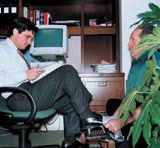Step into my office
The conventions and hierarchy of office life are rich fodder for the observational talents of photographers. Edward Barber punches in

A visit to The Office exhibition at the Photographers’ Gallery will ensure that you never look at offices in the same way again. Given the success of the TV series of the same name, The Office is certainly tapping into the zeitgeist. However, Camilla Jackson, the exhibition’s curator, ‘…didn’t want it to be what people would expect’ and was keen to show mostly ‘challenging, contemporary work’. Consequently, there are less scene-setting archive images than we might have hoped for, but we are presented with 11 bodies of work spanning more than 30 years – some of them never before seen in the UK.
The photographers and artists in the show take two distinct approaches. One group uses the office environment as a stage, builds sets, orchestrates performances and consciously constructs scenarios. The other group uses real situations, people and landscapes found in the office as raw material for a documentary and stalks its prey accordingly. With minimal intervention and maximum observation, this group sees office life as theatre and offers us insights – some all too familiar, some shocking and others just plain bizarre.
The two video artists in the show, John Pilson and Sofia Hultén, are very different, but share a playful and theatrical view of office life. On the other hand, Thomas Demand’s images appear to show anonymous, unpopulated interiors. Closer inspection reveals immaculate sets built from paper and cardboard. These are based on found photographs, such as the desk where Bill Gates designed his first computer operating system. Demand goes to a lot of trouble, and he’s obviously highly skilled, but for set-building with a real edge to it, check out Niall Blankley’s images. He scavenges discarded furniture and obsolete equipment from outside company buildings, assembles them into office-like environments and records his efforts on film.
More stage sets are present in Philip Kwame Apagya’s office pastiches. Using brightly-coloured painted canvas backdrops, he works in the studio shooting his clients as they act out the role of office executives to create humorous portraits.
Lars Tunbjörk’s photographs, taken in large international companies throughout Europe, Japan and America, show us just how absurd and strange offices can look. What are these people up to? You won’t find the answer in David Moore’s overtly melodramatic and harsh flash-lit series of fleeting moments from meetings and workstations. But Jacqueline Hassink provides a much lower key, and more effective, anthropological study of how power is conveyed in office design and architecture. Tim Davis offers us a very personal set of quiet observations, made while he was working at a New York publishing house.
Michael Schmidt’s series from the late 1970s is also subtle – two portraits of the same person, one taken at home, the other at work. The individuals change their clothes and their persona according to the context. The images are poignant; they have a straightforward and almost innocent quality. Julia Knop’s portraits are equally direct: in her 1997-98 series Electronics City she documents people who work in offices outside Bangalore, Southern India. We see people who are part of the growing trend of outsourcing skilled work abroad. The interiors seem indiscernible from their western counterparts, until you start to notice the accoutrements of the tropical climate.
The Office is thought-provoking and well put together. It’s also timely, topical and, just like its TV namesake, highly entertaining.
The Office runs from 27 November 2003 until 18 January 2004 at The Photographers’ Gallery
-
Post a comment




